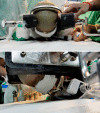Modified prone position using lateral brace attachments for cervico-dorsal spine surgeries
- PMID: 23314870
- PMCID: PMC3698337
- DOI: 10.1007/s00586-012-2653-9
Modified prone position using lateral brace attachments for cervico-dorsal spine surgeries
Abstract
Purpose: The purpose of the study was to propose a method of prone positioning for posterior cervico-dorsal spine surgeries that is easy to achieve without additional equipment and may reduce complications associated with prone positioning in patients.
Methods: 41 patients underwent posterior spine surgeries using our method of prone positioning on a fluoroscopy compatible conventional operation table, and the technical difficulties and complications associated were noted. After induction under general anaesthesia in supine position, cervical tongs were applied. An assembly of two adequately padded cylindrical bolsters and two lateral brace attachments was set on a conventional operating table. The patient was then positioned prone so that the tongs as well as insertion pins of the tongs rest on the lateral brace attachments, with the face and head suspended freely in between. A neutralisation weight was then applied suspended from the tongs to stabilize the head.
Results: The time required for patient positioning was noted and was found to be nearly the same as that required for traditional prone positioning. No problems were noted during patient positioning and with anaesthesia tubing management. All surgeries went well without position related complications except for one patient who developed post-operative macroglossia. All cervical tong pin sites healed without any complications. The fluoroscope easily gained access to the operative areas.
Conclusions: Our modification appears simple, versatile and reproducible for posterior approach procedures of the cervical and upper dorsal spine in prone position. Also, the method can be easily implemented in most conventional operating room facilities with minimal surgeon effort and without the need for any additional inventory.
Figures




Similar articles
-
Lumbar intersegmental spacing and angulation in the modified lateral decubitus position versus variants of prone positioning.Spine J. 2009 Jul;9(7):580-4. doi: 10.1016/j.spinee.2009.04.002. Epub 2009 May 30. Spine J. 2009. PMID: 19482515
-
Effect of the degree of reverse Trendelenburg position on intraocular pressure during prone spine surgery: a randomized controlled trial.Spine J. 2014 Sep 1;14(9):2118-26. doi: 10.1016/j.spinee.2013.12.025. Epub 2014 Jan 20. Spine J. 2014. PMID: 24456677 Clinical Trial.
-
The Effect of Position on PaCO2 and PETCO2 in Patients Undergoing Cervical Spine Surgery in Supine and Prone Position.J Neurosurg Anesthesiol. 2017 Jul;29(3):298-303. doi: 10.1097/ANA.0000000000000322. J Neurosurg Anesthesiol. 2017. PMID: 27271232
-
Ophthalmologic complications associated with prone positioning in spine surgery.J Am Acad Orthop Surg. 2007 Mar;15(3):156-65. doi: 10.5435/00124635-200703000-00005. J Am Acad Orthop Surg. 2007. PMID: 17341672 Review.
-
Advantages and disadvantages of the prone position in the surgical treatment of supracondylar humerus fractures in children. A literature review.Injury. 2018 Nov;49 Suppl 3:S37-S42. doi: 10.1016/j.injury.2018.09.046. Epub 2018 Sep 27. Injury. 2018. PMID: 30286976 Review.
Cited by
-
Consecutive Severe Orofacial Complications in Intensive Care Unit Patients: Quincke's Disease and Macroglossia due to Prolonged Prone Positioning for Management of Acute Respiratory Distress Syndrome.Eur J Case Rep Intern Med. 2022 Aug 24;9(8):003421. doi: 10.12890/2022_003421. eCollection 2022. Eur J Case Rep Intern Med. 2022. PMID: 36093303 Free PMC article.
-
An Innovative Prone Position Using a Body-Shape Plaster Bed and Skull Traction for Posterior Cervical Spine Fracture Surgeries.Front Surg. 2022 Mar 10;9:649421. doi: 10.3389/fsurg.2022.649421. eCollection 2022. Front Surg. 2022. PMID: 35356505 Free PMC article.
References
-
- Jain V, Bithal PK, Rath GP. Pressure sore on malar prominences by horseshoe headrest in prone position. Anaesth Intensive Care. 2007;35:304–305. - PubMed
MeSH terms
LinkOut - more resources
Full Text Sources
Other Literature Sources

